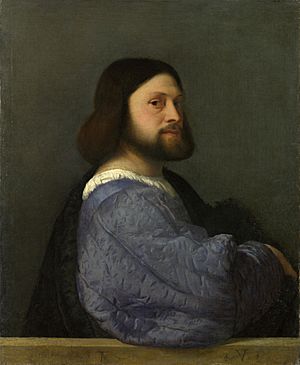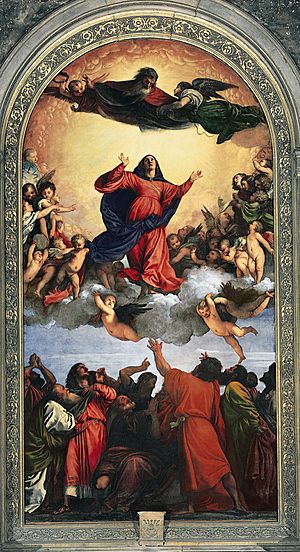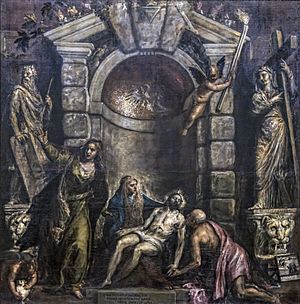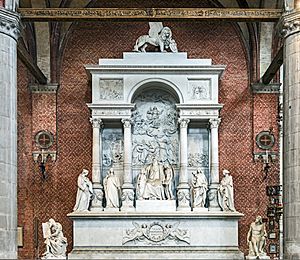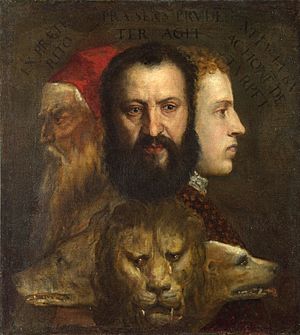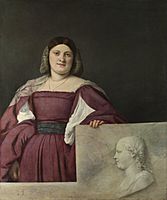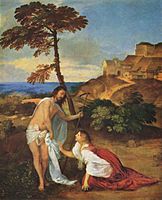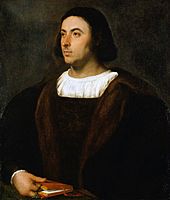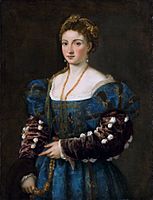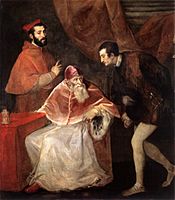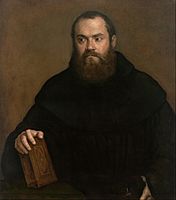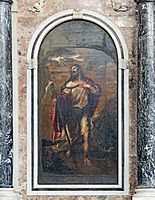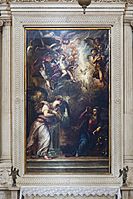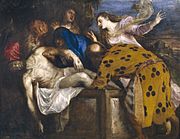Titian facts for kids
Quick facts for kids
Titian
|
|
|---|---|
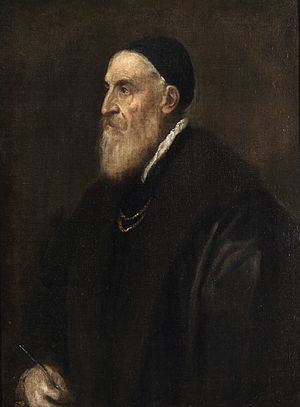
|
|
| Born |
Tiziano Vecellio
c. 1488/90 Pieve di Cadore, Republic of Venice
|
| Died | 27 August 1576 (aged 87–88) Venice, Republic of Venice
|
| Nationality | Venetian |
| Occupation | Italian Renaissance artist |
| Signature | |
 |
|
Titian (born Tiziano Vecellio, around 1488-1490 – August 27, 1576) was a famous Italian painter from Venice. He was a very important artist during the Renaissance period in the 1500s. People at the time called him "The Sun Amidst Small Stars" because he was so brilliant.
Titian was good at painting many different things. He painted portraits of people, beautiful landscapes, and scenes from mythology and the Bible. His way of using and applying color changed how artists painted for many years after him.
He became successful early in his career. Important people, like princes and even the Pope, wanted him to paint for them. Titian, along with another artist named Giorgione, helped start the Venetian School of painting.
Over his long life, Titian's painting style changed a lot. But he always loved using color. His later paintings might not have the bright colors of his early work. However, they showed new ways of using loose brushstrokes and subtle shades that no one had seen before.
Contents
Biography of Titian
Early Life and Training
We don't know the exact date Titian was born. When he was an old man, he said he was born in 1474. But most experts today think he was born later, probably between 1488 and 1490.
Titian's father, Gregorio Vecellio, was in charge of a castle and local mines. His family was well-known in their hometown of Pieve di Cadore, which was part of Venice.
When Titian was about ten to twelve years old, he and his brother Francesco went to Venice. They wanted to become painters. They first trained with an older painter named Gentile Bellini. Later, they moved to the studio of his brother, Giovanni Bellini. The Bellinis were the most important artists in Venice at that time.
In Giovanni Bellini's studio, Titian met other young artists. These included Lorenzo Lotto and Giorgione. Titian's older brother, Francesco, also became a painter.
Some of Titian's earliest works include a painting called Gypsy Madonna. Another early portrait is A Man with a Quilted Sleeve, painted around 1509.
Titian worked as an assistant to Giorgione. Many people at the time thought Titian's work was even better. They worked together on paintings for a building called the Fondaco dei Tedeschi. Their relationship had some rivalry. It's often hard for experts to tell their early works apart.
Titian and Giorgione were seen as leaders of a new style of art. This style was more flexible and less formal than older paintings. After Giorgione died in 1510, Titian continued to paint similar subjects for a while. But his own style quickly grew, using bold and expressive brushstrokes.
Titian also painted frescos (paintings on wet plaster) in Padua in 1511. Some of these, like scenes from the life of St. Anthony of Padua, can still be seen today.
In 1512, Titian returned to Venice. In 1513, he got a special job called La Senseria. This was a profitable privilege that artists really wanted. It meant he was in charge of government art projects. He was supposed to finish paintings left by Giovanni Bellini in the Doge's Palace. He also got a good yearly payment and didn't have to pay certain taxes. In return, he had to paint portraits of the Doges (leaders of Venice). He painted five of them.
Becoming a Master Painter
Between 1516 and 1530, Titian became a true master. He moved beyond his early style and started painting bigger, more complex subjects. After Giorgione died in 1510 and Giovanni Bellini in 1516, Titian became the top artist in Venice. For sixty years, he was the most important painter there.
In 1516, he finished his famous painting, the Assumption of the Virgin. This huge painting is still in the Frari church in Venice. It used color in a grand way that was new for Italy and caused a sensation.
Titian continued to create large, impressive works. One of his most famous is the Pesaro Madonna (around 1519–1526), also for the Frari church. In this painting, Titian showed a new way to arrange groups of people and holy figures in a scene.
By 1521, Titian was very famous, and many people wanted his paintings.
Another important work from this time was The Death of St. Peter Martyr (1530). Sadly, this painting was destroyed in a fire in 1867. Only copies and prints of it remain.
Titian also painted many small Madonnas (paintings of Mary and Jesus). He often placed them in beautiful landscapes. The Virgin with the Rabbit in The Louvre is a good example. This was also when he painted three large, famous mythological scenes for the Duke of Ferrara. These include The Bacchanal of the Andrians and Bacchus and Ariadne (1520–23). These are considered some of the best examples of Renaissance art.
He also painted portraits of young women, like Flora in the Uffizi.
Peak of His Career
Titian's amazing skill with color is clear in his Danaë. This was one of several mythological paintings he called "poesie" (poems). He painted it for a powerful family, and later made another version for King Philip II.
Another famous painting is Bacchus and Ariadne. It shows the god Bacchus arriving and falling in love with Ariadne. This painting was part of a series for the Duke of Ferrara.
From 1530 to 1550, Titian's style continued to develop. In 1538, the Venetian government was unhappy that Titian wasn't finishing his work for the Doge's Palace. They even replaced him for a short time. But Titian worked hard on a painting called Battle of Cadore and got his job back.
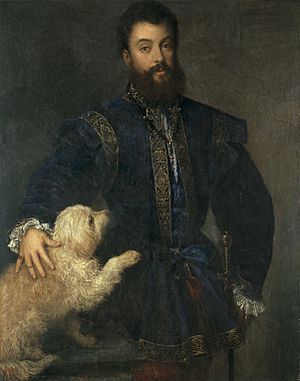
Sadly, the Battle of Cadore was lost in a fire in 1577. It showed a dramatic battle scene with horses and soldiers. It was Titian's attempt to paint a huge, action-filled scene like those by Raphael and Michelangelo. Only a poor copy and a print of it remain.
Other works from this time include the Presentation of the Blessed Virgin (1539) and the Ecce Homo (1541).
Titian was an amazing portrait painter from the very beginning of his career. He painted princes, leaders, cardinals, and writers. People said he was better than other painters at showing both what a person looked like and their inner feelings.
His portraits are often compared to those by Rembrandt and Velázquez. Famous examples include the Portrait of Pope Paul III and the series of portraits of Emperor Charles V. One of the most famous is the Equestrian Portrait of Charles V (1548), which shows the emperor on horseback. This painting created a new style for grand portraits of leaders.
In 1532, after painting Emperor Charles V, Titian was given a special honor. He was made a Count Palatine and a knight. This was a very rare honor for a painter.
Titian was very successful and wealthy. He received payments from powerful people and even had a contract to supply grain. He often visited his hometown of Cadore, where he was generous and influential.
He visited Rome in 1546 and was given the freedom of the city. He also visited Augsburg in 1547 and 1550, where he painted portraits of Charles V and Philip II. The portrait of Philip II was even sent to England to help with Philip's marriage proposal to Queen Mary.
Later Years and Legacy
During the last 26 years of his life (1550–1576), Titian mostly worked for King Philip II and as a portrait painter. He became even more critical of his own work. He was a perfectionist and would keep paintings in his studio for ten years, going back to them and adding new details. This makes it hard sometimes to tell which versions of his paintings are the originals, as his students also made many copies.
For Philip II, he painted a series of large mythological paintings called "poesie." These were mostly based on stories from Ovid. Experts consider these some of his greatest works. Because of later changes in taste, many of these were given away, and only two remain in the Prado Museum today.
The "poesie" series included:
- Danaë (sent to Philip in 1553)
- Venus and Adonis (delivered in 1554)
- Perseus and Andromeda
- Diana and Actaeon
- Diana and Callisto (sent in 1559)
- The Death of Actaeon (started in 1559 but never finished)
These "poesie" paintings were shown together for the first time in almost 500 years in an exhibition in 2020 and 2021.
Titian's later works show deep emotion and drama. For example, The Crowning with Thorns (in the Louvre) is very powerful. He also explored using light and shadow in his night scenes, like Martyrdom of St. Laurence.
Titian's daughter, Lavinia, whom he loved very much, married in 1554. Sadly, she died in childbirth in 1560.
Titian was at the Council of Trent around 1555. His friend, the writer Pietro Aretino, died in 1556, and his friend, the sculptor Jacopo Sansovino, died in 1570. In 1565, Titian designed decorations for a church in his hometown.
Around 1560, Titian painted Madonna and Child with Saints Luke and Catherine of Alexandria. Some parts of this painting might have been done by his students.
He kept taking on new art projects until the end of his life. His last painting, the Pietà, is a dramatic scene of suffering. He probably meant it for his own tomb. He wanted to be buried in the Frari church in Venice. He offered the church a painting of the Pietà in exchange for a grave. He almost finished it, but then changed his mind and decided to be buried in his hometown.
Death of Titian
Titian died on August 27, 1576, during a terrible outbreak of the bubonic plague in Venice. He was either in his late eighties or almost 100 years old, depending on his exact birth date. He was buried in the Frari church, as he had first planned. His Pietà painting was finished by another artist, Palma il Giovane. Titian's grave didn't have a memorial for a long time. Much later, the Austrian rulers of Venice asked Antonio Canova to create the large monument that is there today.
Soon after Titian died, his son and assistant, Orazio, also died from the plague. This made it very difficult to sort out Titian's belongings, as he hadn't made a will.
Printmaking and Materials
Titian and Prints
Titian never made engravings himself. But he knew that prints were a great way to spread his fame. Between 1517 and 1520, he designed many woodcuts, including a huge one of The Crossing of the Red Sea. He also worked with other artists who made prints based on his paintings and drawings. Later, he gave drawings to artists like Cornelis Cort and Martino Rota, who made engravings from them.
Painting Materials Used
Titian used a wide range of colors in his paintings. He used almost every pigment available during his time. Besides common Renaissance colors like ultramarine (a deep blue), vermilion (a bright red), and lead-tin-yellow, he also used rare ones like realgar (an orange-red) and orpiment (a yellow).
Titian's Family and Workshop
Titian's wife, Cecilia, was from his hometown. She was his housekeeper and partner for about five years before they married. They had two sons, Pomponio and Orazio. In 1525, when Cecilia became very ill, Titian married her to make their children legitimate. Cecilia got better, and they had another daughter who died as a baby. Cecilia died in August 1530. Titian married again, but we don't know much about his second wife. He also had a fourth child, Emilia, with another woman. His favorite child was Orazio, who became his assistant.
After Cecilia died, Titian moved his children to a new home. His sister Orsa came from Cadore to help manage the house. His mansion was in a fashionable part of Venice, with beautiful gardens and a view of the sea.
Around 1526, Titian became close friends with Pietro Aretino, a very influential writer.
When he was very young, the famous Italian painter Tintoretto was brought to Titian's studio. This was around 1533. Tintoretto was only in the studio for ten days when Titian sent him home. Some people think Titian was jealous of Tintoretto's talent. Others think Titian felt that Tintoretto was too independent to be a proper student. They remained distant, and Titian was not friendly towards Tintoretto.
Several other artists in the Vecelli family followed Titian's path. His older brother, Francesco Vecellio, also painted. Marco Vecellio, Titian's nephew, was always with him in his old age and learned his painting methods. Marco painted some works in the Doge's Palace.
Other relatives who were painters included Fabrizio di Ettore and Cesare Vecelli. Cesare is well-known for his book of engraved costumes. Another relative, Girolamo Dante, was Titian's assistant. Many of his paintings were touched up by Titian, making them hard to tell apart from Titian's originals.
Not many of Titian's students became famous artists on their own. Being his assistant was often a lifelong job. Some known assistants include Paris Bordone and Bonifazio Veronese. It's also said that Titian employed El Greco in his last years.
Titian's Art Today
Experts believe Titian created about 400 works, and around 300 of them still exist today.
In 2008, two of Titian's paintings that were owned privately were put up for sale. One of them, Diana and Actaeon, was bought by the National Gallery in London and the National Galleries of Scotland in 2009 for £50 million. This sale caused some debate among politicians who thought the money could have been used differently during an economic downturn. The other painting, Diana and Callisto, was also for sale for the same amount until 2012.
Gallery of Works
-
Noli me tangere, 1511–15, National Gallery London
-
Man with a glove, c. 1520, Louvre Museum, Paris
-
La Bella, c. 1536, Palazzo Pitti, Florence
-
Pope Paul III and His Grandsons, c. 1546; Museo di Capodimonte, Naples
-
A monk with a book, c. 1550, National Gallery of Victoria, Melbourne
-
The Entombment, c. 1572, Prado Museum, Madrid
See also
 In Spanish: Tiziano para niños
In Spanish: Tiziano para niños


